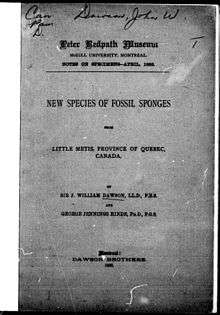George Jennings Hinde
| George Jennings Hinde | |
|---|---|
| Born |
March 24, 1839 Norwich |
| Died |
March 18, 1918 (aged 78) Croydon |
| Nationality | British |
| Awards | Lyell Medal |
| Scientific career | |
| Fields | sponges, annelids and conodonts paleontology |
| Thesis | [[1] Fossil Sponge-Spicules from the Upper Chalk, found in the Interior of a Single Flintstone from Horstead Norfolk.] (1880) |
| Doctoral advisor | Professor Karl Alfred Ritter von Zittel (1839-1904) |
George Jennings Hinde (24 March 1839 – 18 March 1918) was a British geologist[2] and paleontologist.
Works
Extensive studies on scolecodonts by George J. Hinde of material from England, Wales, Canada and Sweden [3][4][5][6] established a basis for the nomenclature of what he regarded as being isolated components of annelid jaws; but study of them lapsed thereafter for almost 50 years.
He also studied conodonts from Canada and the United States[7] or from Scotland.[8] He named the genus Polygnathus in 1879.[9]
_BHL12327684.jpg)
He published the Catalogue of the fossil sponges in the Geological Department of the British Museum (Natural History). With descriptions of new and little-known species (Illustrated by 38 lithographic plates.) in 1883[10]

In 1888, he published with John William Dawson New species of fossil sponges from Little Metis, province of Quebec, Canada.
Awards
In 1896, he became a Fellow of the Royal Society.
In 1897, he was a recipient of the Lyell Medal, a prestigious annual scientific medal given by the Geological Society of London.
Tributes
The Hinde Medal is an award given by the Pander Society, an informal organisation founded in 1967 for the promotion of the study of conodont palaeontology.
The conodont genera Hindeodella, Hindeodelloides and Hindeodus are named after G.J. Hinde.[11]
The specific epithet hindei, referring to prehistoric animals, is a tribute to G.J. Hinde. It can be found in species such as:
- Diagoniella hindei, a sponge species
- Choia hindei, a sponge species
- Calceolispongia hindei, a crinoid species
References
- ↑ Fossil Sponge-Spicules from the Upper Chalk, found in the Interior of a Single Flintstone from Horstead Norfolk. George Jennings Hinde, F.G.S. With five Plates. 8vo. Munich, 1880, Annals and Magazine of Natural History (5) 7: 268-269 (1881), doi:10.1080/00222938109459506
- ↑ O'Connell, M. (1918). "George Jennings Hinde". Science. 48 (1250): 588–90. doi:10.1126/science.48.1250.588. PMID 17738453.
- ↑ HINDE, G. J. 1879. On annelid jaws from the Cambro-Silurian, Silurian and Devonian Formations in Canada and from the Lower Carboniferous in Scotland. Quarterly Journal of the Geological Society of London, 35, 370-389.
- ↑ HINDE, G. J. 1880. On annelid jaws from the Wenlock and Ludlow Formations of the west of England. Quarterly Journal of the Geological Society of London, 36, 368-378.
- ↑ HINDE, G. J. 1882. On annelid remains from the Silurian strata of the Isle of Gotland. Birand till Kungliga Svensk Vetenskapsakademiens, Hindlingas, 7, 3-28.
- ↑ HINDE, G. J. 1896. On the jaw-apparatus of an annelid (Eunicites reidiae sp. nov.) from the Lower Carboniferous of Halkin Mountain, Flintshire. Quarterly Journal of the Geological Society of London, 52, 438-450.
- ↑ On Conodonts from the Chazy and Cincinnati Group of the Cambro-Silurian, and from the Hamilton and Genesee-Shale Divisions of the Devonian, in Canada and the United States. Hinde, George Jennings, 1879, Quarterly Journal of the Geological Society of London, v. 35, part 3, no. 139, p. 351-369, pls. XV– XVII (with discussion on p. 389), doi:10.1144/GSL.JGS.1879.035.01-04.23
- ↑ Notes and descriptions of new species of Scotch Carboniferous conodonts. GJ Hinde - Transactions of the Natural History Society of Glasgow, 1900
- ↑ Lower Devonian Subspecies of the Conodont Polygnathus linguiformis Hinde from Southeastern Australia. G. M. Philip and J. H. Jackson, Journal of Paleontology, Vol. 41, No. 5 (Sep., 1967), pages 1262-1266 (Stable URL retrieved 1st May 2016)
- ↑ Catalogue of the fossil sponges in the Geological Department of the British Museum (Natural History). With descriptions of new and little-known species. (Illustrated by 38 lithographic plates.) By George Jennings Hinde. British Museum (Natural History). Department of Geology. London, Printed by order of the Trustees,1883.doi:10.5962/bhl.title.12006
- ↑ Pander Society Newsletter #39, July 2007 (retrieved 1st May 2016)
External links

- Obituary—George Jennings Hinde by Henry Woodward - 1918 (retrieved 1 May 2016)